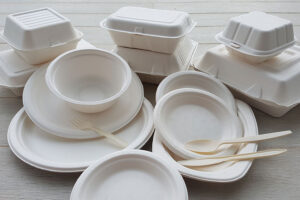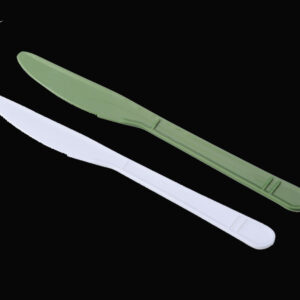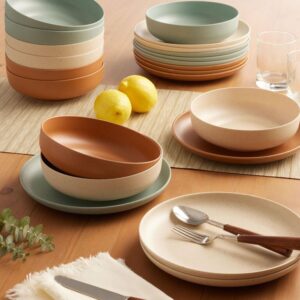

In recent years, there has been a surge in interest and demand for environmentally-friendly alternatives to traditional single-use plastics. As the world becomes more conscious of the detrimental impact of plastic waste on our planet, industries are exploring sustainable alternatives in various sectors. One alternative that has gained significant attention and popularity is disposable cornstarch tableware. In this blog post, we will delve into the cost analysis of this eco-friendly option, exploring its advantages, drawbacks, and financial implications for industry buyers.
Introduction
Disposable cornstarch, biodegradable tableware, or PLA (Polylactic Acid) tableware is made from renewable resources such as cornstarch, sugarcane, or cassava roots. Unlike conventional plastic tableware, these products are compostable and break down naturally over time, reducing the strain on landfills. As more businesses and individuals embrace sustainability, evaluating the costs associated with adopting disposable cornstarch tableware as an alternative to plastic options becomes crucial.
Cost Considerations
1.Manufacturing Costs
The manufacturing process for disposable cornstarch tableware involves several steps, including raw material sourcing, processing, and molding. Compared to plastic tableware manufacturing, the initial production costs for cornstarch-based alternatives can be higher. Additional resources and specialised machinery are required to extract and process natural resources into a biodegradable material, which can impact the overall cost of production.
2.Increased Demand
With the growing demand for products that are environmentally friendly, the market for disposable cornstarch tableware has expanded significantly. As a result, economies of scale have come into play, reducing manufacturing costs. Bulk orders and larger volumes allow manufacturers to optimize production processes, lowering the price per unit. This benefits industry buyers looking to procure large quantities of disposable tableware.
3.Product Price Comparison
There may be a slight difference in cost when comparing the price of disposable cornstarch tableware to traditional plastic tableware. While the upfront investment in biodegradable alternatives could be marginally higher, these costs should be evaluated over the product’s lifecycle. In some cases, the positive environmental impact and potential waste management cost savings can offset the price difference.
Advantages of Disposable Cornstarch Tableware
1.Environmental Benefits
One of the primary advantages of disposable cornstarch tableware is its eco-friendly nature. As PLA-based products decompose naturally, they do not contribute to the accumulation of harmful plastic waste. By adopting biodegradable alternatives,businesses can reduce their carbon footprint and be part of a healthier environment. This environmental advantage can be a significant selling point for companies aiming to enhance their sustainability efforts and attract environmentally-conscious customers.
2.Versatility and Aesthetic Appeal
Disposable cornstarch tableware offers a wide range of design, shape, and size options, similar to traditional plastic counterparts. These bio-based products can be molded into various forms, making them suitable for different occasions such as weddings, parties, or professional events. The aesthetic appeal of cornstarch tableware, combined with its eco-friendly nature, provides an excellent alternative for businesses aiming to create an eco-conscious and visually appealing atmosphere for their customers.
3. Biodegradability and Compostability
Unlike plastic tableware that takes hundreds of years to decompose, disposable cornstarch tableware breaks down in a composting environment within a few months. Composting provides valuable organic matter that can be used for agricultural purposes, closing the loop and contributing to a circular economy. By choosing compostable tableware, industry buyers actively participate in the waste management system, promoting sustainability and responsible waste disposal.
Drawbacks and Limitations
1.Limited Heat Resistance
Disposable cornstarch tableware has a limited heat resistance capacity compared to plastic dishes. While they can withstand moderate temperatures, such as those from hot beverages, they may not be suitable for high-temperature applications such as microwaving or holding scorching foods. Industry buyers should consider the specific requirements of their business operations when evaluating the feasibility of using cornstarch-based tableware.
2.Durability and Sturdiness
PLA-based tableware may not be as durable or sturdy as traditional plastic tableware. While technological advancements have improved cornstarch alternatives’ strength and resilience, they may not perform as well under certain circumstances. For example, if a customer is likely to use excessive force while cutting food on a plate, disposable cornstarch tableware might not be the ideal choice. Businesses should understand their unique operational needs and assess the suitability of these products accordingly.
3.Cost Comparison and Perceived Value
Although the price difference between disposable cornstarch tableware and plastic tableware is minimal, some customers may perceive biodegradable alternatives as more expensive. Businesses need to educate their customers about the long-term benefits of using sustainable options and emphasize the positive environmental impact of their choices. Transparent communication about the cost differences and the value proposition associated with greener alternatives can help overcome any potential hesitations from customers.
Conclusion
Disposable cornstarch tableware offers a sustainable and environmentally-conscious alternative to traditional plastic silver. While the initial manufacturing costs may be slightly higher, the overall benefits outweigh the financial implications for industry buyers. Cornstarch-based tableware’s eco-friendly nature, versatility, and compostability attract businesses and individuals looking to reduce their environmental impact.
As the demand for sustainable solutions grows, economies of scale and increased market competition gradually reduce Disposable cornstarch cutlery costs. Before transitioning to biodegradable alternatives, industry buyers should carefully consider their specific requirements, such as heat resistance, durability, and cost comparison.
By embracing disposable cornstarch tableware, businesses can demonstrate their commitment to sustainability, attract environmentally-conscious customers, and contribute to a greener future. As the world continues to move towards a more circular economy, exploring and investing in eco-friendly solutions that help protect our planet for future generations is imperative.







